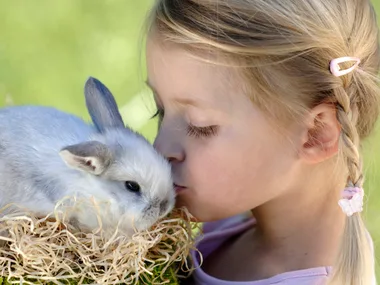Australia has one of the highest rates of pet ownership in the world. About 62% of Australian households own pets and there are estimated to be over 24 million pets in Australia.
For many pet owners, the pleasure and fun of a four-legged companion far outweighs the animal-borne baddies it may bring home. But how can we be sure our kids are safe from harm?
Not surprisingly, family pets (and their accompanying germs and worms) are at the centre of a modern health dilemma that scientists have coined the ‘hygiene hypothesis’.
The theory suggests that while our increasing obsession with staying germ-free can prevent the spread of disease and infections, leading a cleaner lifestyle may also be responsible for an increase in allergies among children.
Bringing further weight to the argument, research into pets and allergens conducted in the US found that babies exposed to an indoor dog or cat in their first year of life were half as likely to develop animal allergies.
While some children will suffer from animal allergies no matter what, allergens are just one possible health hazard posed by contact with pets. Potentially, your pet can transmit a range of ‘zoonotic’ or animal-to-human diseases.
Some examples of these diseases are rabies (via fleas on rodents, cats and rabbits), ringworm (a fungal infection, not an actual worm), cat scratch fever, parasites such as worms, tick paralysis and tuberculosis.
Infants are going to be particularly susceptible to pet-transmitted diseases and germs due to their immature immune systems, poor hygiene and tendency to have their hands in their mouth.
So how can we interact with our beloved pets in a healthy, fun way without putting our kids at risk?
DOGGY DO’S & DON’TS
Toddlers often love rolling, wresting and swapping kisses with the family dog. Here’s how to focus on the fun and fight off the germs.
• Don’t allow fur pulling or other pet meddling by your toddler. If the dog gets upset and nips or bites, germs in his saliva can cause a potentially serious skin infection. Most mature dogs will have some level of tooth decay or gum disease, with its associated bacteria.
• If you’re sneezing, it may not be the dog itself you’re reacting to, but the dust mites that thrive in places where Fido spends most of his time. Replace dog beds once a year, especially if they are in the basement.
• Bathing dogs has this has been shown to reduce the levels of Can F1 (the protein in dog dander that causes allergic reactions) by as much as 84 percent.

Pets are proven to bring children emotional and physical benefits.
(Image: Getty Images)• Don’t feed your dog in the kitchen as dry pet food can carry salmonella. Infections are more likely in young children if pets are fed in the kitchen.
• Doggie treats can be tempting for toddlers to eat and water bowls are fun to splash in, but all of these can carry germs. Place them where your child can’t reach or have him wash his hands after handling them.
• Discourage your toddler from putting your dog’s toys in their own mouth and regularly wash dog toys. You may even decide to remove the dog’s toys until your child is older.
• Most doctors and vets say sleeping in the same bed with a pet isn’t a good idea, so ensure the dog has its own bed outside of the bedroom.
• As part of the whole ‘washing our hands’ lesson, make sure your child knows to do so after petting his pooch.
• Keep the dog’s yard clean of droppings. Dog droppings can carry bacteria and parasites like hookworms.
• Finally, don’t let your dog lick your child’s face or skin – especially if your kid has an open wound, like a scraped knee. Contrary to the French saying which translates as ‘A dog’s tongue is a doctor’s tongue’, dog saliva is neither clean nor antibacterial.

Like with dogs, teach your child to wash hands after petting the cat
(Image: Getty Images)CAT CAUTIONS
Cats can be cuddly or deliver a quick swipe of the claw when provoked. Here’s how to reduce the risks…
• Keep your crawler or toddler away from the kitty litter box. Cat droppings carry infection-causing germs.
• It’s also important that you don’t come into contact with cat droppings while you are pregnant as their faeces contains a parasite that can cause toxoplasmosis. This is an infection that can lead to miscarriage or harm your unborn child.
• Most cats will try to worm their way onto your bed if given the chance, so it’s important to set up a spot for them to sleep outside the bedroom – paediatricians particularly warn against babies and kids sleeping with cats.
• Don’t let the cat lick your child’s face or skin, especially if they have are any sores, scratches or open wounds. Despite popular myths, cat’s saliva is not medicinal.
• Like with dogs, teach your child to wash hands after petting the cat.
PET BENEFITS
Having a companion animal has been scientifically proven to bring a multitude of emotional and physical benefits to children as they grow up, from lowering blood pressure and reducing allergies to increasing self-esteem and encouraging nurturing qualities.
So while it’s important to be aware of hygiene and safety when interacting with your pets, most owners would tell you the risks are far outweighed by the feel-good factor.




